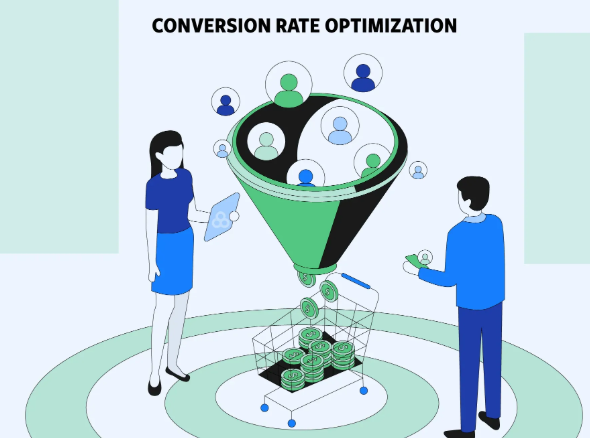In today’s competitive digital landscape, your Google Business Profile (GBP) is more than just a listing — it’s a powerful conversion tool. With the right Conversion Rate Optimization (CRO) strategies, your Google profile can transform from a simple directory listing into a lead-generating powerhouse.
Whether you’re a local contractor, salon owner, dentist, or any small business owner, optimizing your GBP elements like call-to-action buttons, high-quality images, business descriptions, and timely posts can significantly improve clicks, calls, bookings, and website visits directly from search results. Let’s dive into how you can supercharge your Google Business Profile using CRO best practices to boost your local visibility and turn profile visitors into paying customers.
Why CRO Matters for Google Business Profile
When someone searches for your business or related services, your Google Business Profile (formerly Google My Business) often appears front and center — especially on Google Maps and the Local 3-Pack. Unlike website traffic, people who find you on Google Maps are ready to act.
That’s where CRO (Conversion Rate Optimization) steps in. By optimizing how your listing looks and functions, you can:
- Increase phone calls and quote requests
- Boost clicks to your website
- Improve directions requests
- Drive more appointment bookings
Instead of just being seen, your business becomes chosen. That’s the magic of optimizing your GBP for conversions.

What Is CRO for Google Business Profile?
CRO for your Google profile means making your listing more persuasive and action-driven. It’s about refining elements like:
- Your business description
- The call-to-action (CTA) buttons
- Eye-catching photos and videos
- Compelling Google Posts
- Accurate categories and attributes
These elements not only help you rank in local search (a key part of Local SEO) but also encourage immediate action from potential customers.
Essential GBP Elements to Optimize for Higher Conversions
Let’s explore the most critical GBP features you should focus on — and how to optimize each for maximum engagement and conversion.
1. Business Description: Turn Browsers into Buyers
Your business description is prime real estate for keywords and persuasion. It appears right in the middle of your profile — and can instantly set you apart.
CRO Tips for Optimizing GBP Description:
- Use keyword-rich language (e.g., “affordable landscaping in Brooklyn” or “custom screen printing for events”)
- Clearly explain your unique selling points (USP)
- Include a light call-to-action at the end (“Call today for a free quote!”)
Keep it friendly, professional, and conversational
2. Call-to-Action Buttons: Make It Easy to Convert
CRO is all about removing friction. That’s why your CTA buttons matter.
GBP includes built-in CTA options like:
- “Call Now”
- “Visit Website”
- “Book Online”
- “Get Directions”
- “Message”
CRO Tips:
- Ensure your phone number is correct and trackable
- Use UTM tracking for the website link to measure clicks and conversions
- Link “Book” to a fast-loading booking tool or contact form
- Enable the Messaging feature and respond quickly
CRO Insight: Businesses that add a “Book Online” button often see up to 30% more engagement compared to listings without one.
3. Photos and Videos: Visual CRO That Converts
People buy what they see. Your images speak volumes about your professionalism and trustworthiness.
CRO Tips for GBP Visuals:
- Upload real, high-resolution photos of your storefront, team, and services
- Add before-and-after images if relevant (contractors, beauty services, etc.)
- Use geotagged images to support local SEO
- Post short video walkthroughs or customer testimonials
Keyword-rich alt text (added via image names or posts) helps search engines associate your listing with local and service-specific keywords.
CRO Hack: Businesses with 100+ quality images get up to 500% more views than those with fewer than 10.
4. Google Posts: Drive Timely Actions
Think of Google Posts as mini social media updates that appear on your listing. They’re fantastic for limited-time offers, events, product highlights, and news updates.
CRO Tips for Posts:
- Add strong CTAs like “Call Now,” “Learn More,” “Book Online,” or “Order Now”
- Use action-oriented headlines: “20% Off This Week Only!”
- Include local terms and service variations
- Add clear images or graphics
- Keep posts short and benefit-focused
Pro Tip: Updating your GBP weekly with fresh posts signals activity to Google, which can enhance rankings and increase conversions.
5. Services and Categories: Help Google Help You
Many businesses overlook this — but choosing the right primary and secondary categories is a key step in both local visibility and CRO.
CRO Optimization Tips:
- Choose the most specific primary category (e.g., “Hairdresser” not “Beauty Salon”)
- Add all relevant services, each with keyword-rich descriptions
- Use synonyms and variations: “landscape design,” “yard remodeling,” “outdoor upgrades”
Local SEO Bonus: The more specific your categories and services are, the easier it is for Google’s algorithm to match your business with buyer intent searches.
Bonus CRO Tactics to Maximize Google Profile Leads
Besides optimizing the core GBP elements, here are additional conversion rate tips to go even further:
- Enable Appointment Links using tools like Calendly, Square, or a booking plugin
- Use Google Q&A strategically: Ask and answer your own questions to highlight services
- Track GBP insights weekly to monitor clicks, calls, directions, and bookings
Add “People Also Ask” FAQs in Posts to address common objections
EEAT Principles for GBP CRO (Expertise, Experience, Authority, Trust)
To truly stand out in local search and convert more leads, your listing should reflect EEAT, Google’s quality signal framework:
- Expertise: Show this through detailed posts, professional photos, and knowledgeable responses
- Experience: Highlight years in business, certifications, and specialties
- Authority: Get backlinks from local directories and business sites
- Trust: Earn glowing reviews and respond to concerns promptly
Combining CRO and EEAT ensures that your profile doesn’t just rank — it convinces.
Real-World Impact: What Results Can You Expect?
With consistent GBP optimization and CRO tactics, businesses typically see:
- 25%–50% increase in profile engagement
- 15%–40% lift in phone calls
- Higher website traffic from search
- More customer actions without visiting your website
It’s a low-effort, high-impact strategy — and one of the best-kept secrets in local lead generation.
Final Thoughts: Make Your GBP a Conversion Engine
Your Google Business Profile is your #1 free digital asset — and with a few smart conversion tweaks, it can become your most reliable sales tool.
Start by reviewing your:
✅ Description
✅ CTA buttons
✅ Photos and videos
✅ Google Posts
✅ Categories and Services
✅ Review strategy
Then apply the CRO and Local SEO tips shared in this guide to boost your visibility and turn profile views into actions.
Remember: People are already searching for what you offer. Make sure your GBP is optimized to convert when they find you.
If you need an expert advice, contact us today!


